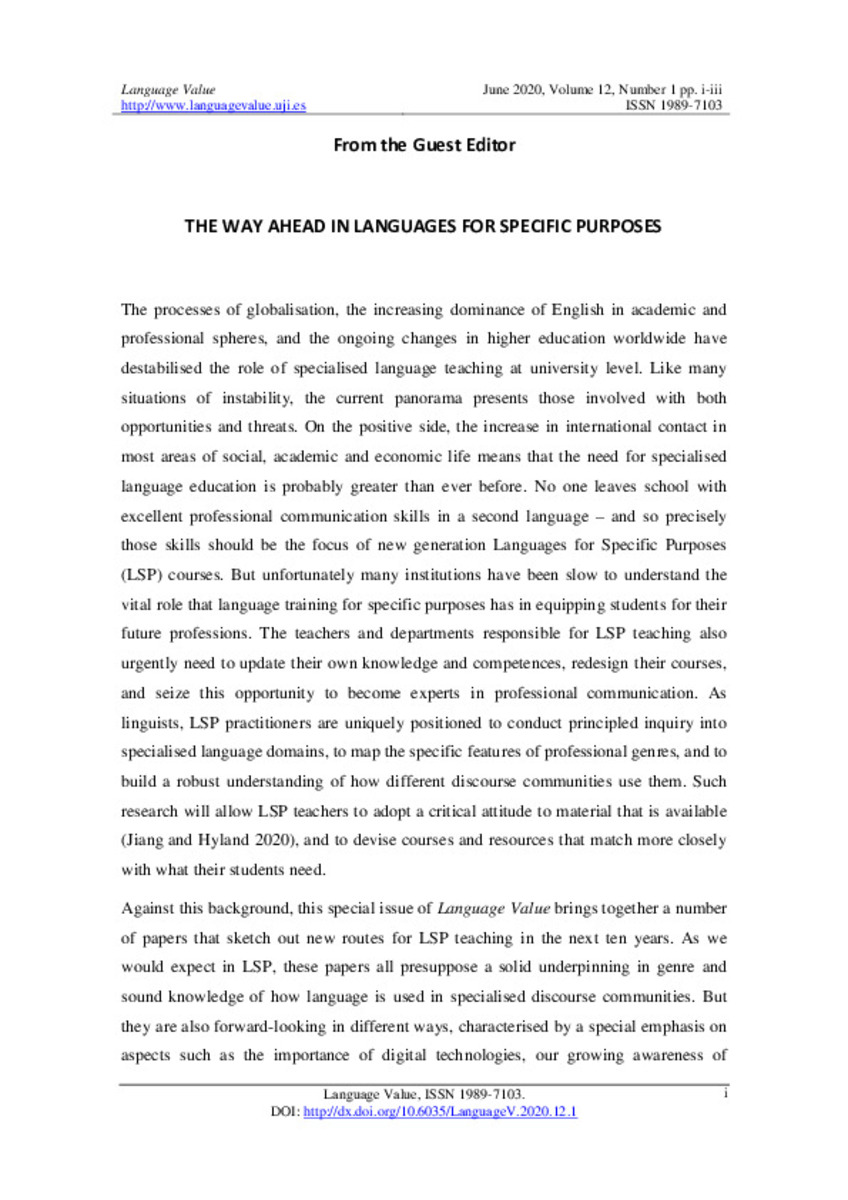Full metadata record
| DC Field | Value | Language |
|---|---|---|
| dc.creator | Breeze, R. (Ruth) | - |
| dc.date.accessioned | 2022-12-20T10:37:00Z | - |
| dc.date.available | 2022-12-20T10:37:00Z | - |
| dc.date.issued | 2020 | - |
| dc.identifier.citation | Breeze, R. (Ruth). "The way ahead in languages for specific purposes". Language Value. (12), 2020, | es |
| dc.identifier.issn | 1989-7103 | - |
| dc.identifier.uri | https://hdl.handle.net/10171/64907 | - |
| dc.description.abstract | The processes of globalisation, the increasing dominance of English in academic and professional spheres, and the ongoing changes in higher education worldwide have destabilised the role of specialised language teaching at university level. Like many situations of instability, the current panorama presents those involved with both opportunities and threats. On the positive side, the increase in international contact in most areas of social, academic and economic life means that the need for specialised language education is probably greater than ever before. No one leaves school with excellent professional communication skills in a second language – and so precisely those skills should be the focus of new generation Languages for Specific Purposes (LSP) courses. But unfortunately many institutions have been slow to understand the vital role that language training for specific purposes has in equipping students for their future professions. The teachers and departments responsible for LSP teaching also urgently need to update their own knowledge and competences, redesign their courses, and seize this opportunity to become experts in professional communication. As linguists, LSP practitioners are uniquely positioned to conduct principled inquiry into specialised language domains, to map the specific features of professional genres, and to build a robust understanding of how different discourse communities use them. Such research will allow LSP teachers to adopt a critical attitude to material that is available (Jiang and Hyland 2020), and to devise courses and resources that match more closely with what their students need. | es_ES |
| dc.language.iso | spa | es_ES |
| dc.publisher | Universidad Jaume I | es_ES |
| dc.rights | info:eu-repo/semantics/openAccess | es_ES |
| dc.subject | Language | es_ES |
| dc.subject | Specific purpose | es_ES |
| dc.subject | Multimodality | es_ES |
| dc.subject | Phrasal verbs | es_ES |
| dc.subject | Metonymy | es_ES |
| dc.title | The way ahead in languages for specific purposes | es_ES |
| dc.type | info:eu-repo/semantics/article | es_ES |
| dc.description.note | Attribution-NonCommercial 4.0 International (CC BY-NC 4.0) | es_ES |
| dc.identifier.doi | 10.6035/LanguageV.2020.12.1 | - |
| dadun.citation.number | 12 | es_ES |
| dadun.citation.publicationName | Language Value | es_ES |
Files in This Item:
Statistics and impact
Items in Dadun are protected by copyright, with all rights reserved, unless otherwise indicated.






